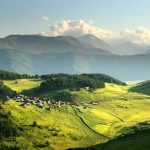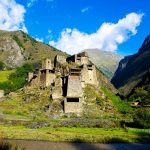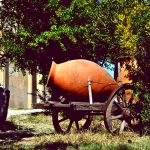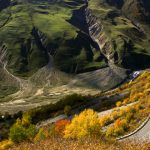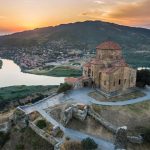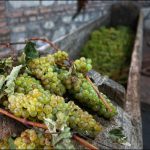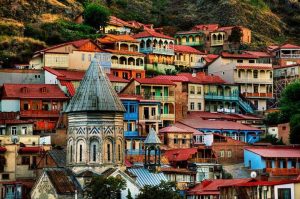 The south Georgian region of Kemo Kartli is one of Georgia’s most overlooked treasures. Although much of the region is just a short drive from Tbilisi, and is full of natural beauty and ancient monuments, many travelers ignore it for more famous parts of Georgia. This is a mistake, as the area is a fascinating patchwork of nationalities, climates and topographies. The plains south of Tbilisi are rich agriculturally, and are home to many Azerbaijani communities. These villages contain great examples of vernacular Azeri architecture, as well as a smattering of newly built mosques. Climbing higher onto the plateau around the town of Tsalka, and the population is an intriguing mixture of Georgian, Armenian and Pontic Greek, the latter the last remnants of a community that inhabited the Black Sea littoral since classical times. The capital of the region is Rustavi, and industrial, Soviet town that has fallen on hard times. Once a massive metallurgical factory, the are is now economically depressed and looks like something out of Mad Max. in spite of this, or perhaps because of it, the town is still worth visiting by those interested in Soviet architecture, as it has an ‘old’ centre completed in Stalinist style, and a later addition built under Brezhnev and wholly modernist. Most visitors, however, will want to head for the regions many ancient monuments, including Bolnisi Sioni, the oldest major church in Georgia. Built in 480, this hulking basilica made of distinctive blue-green tuff contains the oldest Georgian inscription so far discovered in the country (older ones have been found in Palestine), and it’s sheer size and austerity make it a remarkable monument from what are often described as the ‘dark ages’. Further to the south west, about a two hour drive from Tbilisi, is the fascinating Archaeological site of Dmanisi. As well as being notable as the oldest hominid site outside Africa, the medieval remains of Dmanisi city are also very impressive. The ruins of the royal palace, built – inevitably – on a cliff, still contain its original bathhouses, and ancient churches and escape tunnels complete the picture of a heavily defended medieval town. The complex is set on a natural rock spur, overlooking lush wooded valleys that cry out for picnicking. Visit during March or April and you won’t be able to sit down without finding stands of wild asparagus. Nature lovers, veteran hikers, canyoners and adventurers, meanwhile, should head to the natural labyrinth of the Birtvisi canyons. This massive complex of limestone crevasses and ravines are one of the most spectacular – and most fun – hiking destinations in Georgia. just an hor from Tbilisi, the hidden valleys of Birtvisi contain secret castles, springs and waterfalls, all set in the most amazing limestone massif. There is enough to explore here to keep you busy for weeks, but it might be worth taking a guide, and the place really is a maze.
The south Georgian region of Kemo Kartli is one of Georgia’s most overlooked treasures. Although much of the region is just a short drive from Tbilisi, and is full of natural beauty and ancient monuments, many travelers ignore it for more famous parts of Georgia. This is a mistake, as the area is a fascinating patchwork of nationalities, climates and topographies. The plains south of Tbilisi are rich agriculturally, and are home to many Azerbaijani communities. These villages contain great examples of vernacular Azeri architecture, as well as a smattering of newly built mosques. Climbing higher onto the plateau around the town of Tsalka, and the population is an intriguing mixture of Georgian, Armenian and Pontic Greek, the latter the last remnants of a community that inhabited the Black Sea littoral since classical times. The capital of the region is Rustavi, and industrial, Soviet town that has fallen on hard times. Once a massive metallurgical factory, the are is now economically depressed and looks like something out of Mad Max. in spite of this, or perhaps because of it, the town is still worth visiting by those interested in Soviet architecture, as it has an ‘old’ centre completed in Stalinist style, and a later addition built under Brezhnev and wholly modernist. Most visitors, however, will want to head for the regions many ancient monuments, including Bolnisi Sioni, the oldest major church in Georgia. Built in 480, this hulking basilica made of distinctive blue-green tuff contains the oldest Georgian inscription so far discovered in the country (older ones have been found in Palestine), and it’s sheer size and austerity make it a remarkable monument from what are often described as the ‘dark ages’. Further to the south west, about a two hour drive from Tbilisi, is the fascinating Archaeological site of Dmanisi. As well as being notable as the oldest hominid site outside Africa, the medieval remains of Dmanisi city are also very impressive. The ruins of the royal palace, built – inevitably – on a cliff, still contain its original bathhouses, and ancient churches and escape tunnels complete the picture of a heavily defended medieval town. The complex is set on a natural rock spur, overlooking lush wooded valleys that cry out for picnicking. Visit during March or April and you won’t be able to sit down without finding stands of wild asparagus. Nature lovers, veteran hikers, canyoners and adventurers, meanwhile, should head to the natural labyrinth of the Birtvisi canyons. This massive complex of limestone crevasses and ravines are one of the most spectacular – and most fun – hiking destinations in Georgia. just an hor from Tbilisi, the hidden valleys of Birtvisi contain secret castles, springs and waterfalls, all set in the most amazing limestone massif. There is enough to explore here to keep you busy for weeks, but it might be worth taking a guide, and the place really is a maze.
+995 597 293841
[email protected]

